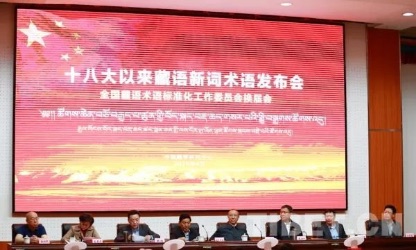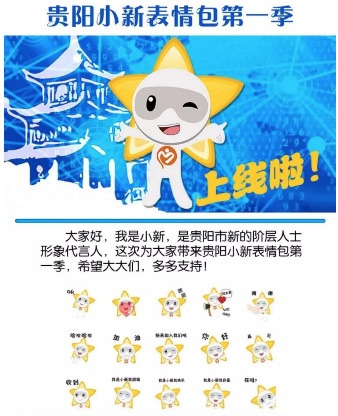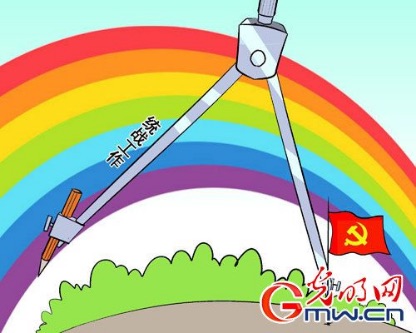The United Front represents your meaning: Tibetan neologisms, New Social Strata emojis and the Sagerean Section
« previous post | next post »
[This is a guest post by Jichang Lulu.]
A recent paper by Alex Joske features Sitar སྲི་ཐར་ (Wylie Sri thar, Chinese transcription Sita 斯塔), a senior CCP united front cadre. Sitar's career included decades at the Central United Front Work Department, of which he was a vice head between 2006 and 2016. He later became a deputy director of the office of the Party's Central Coordination Group for Tibetan Affairs (Zhōngyāng Xīzáng Gōngzuò Xiétiáo Xiǎozǔ 中央西藏工作协调小组). On at least two occasions, he led Central United Front Work Leading Small Group inspection groups, thus earning mention in Joske's paper, of which said Group is the main topic.
‘Xi Jinping Thought’, another 1499 Tibetan neologisms, and more
A more recent thing Deputy Director Sitar has presided over should perhaps earn him a mention on this Log, by virtue of its subject-matter. On 28 April 2018, Sitar was the top cadre speaking at the presentation of “more than 1500” Tibetan neologisms coined since the 18th Party Congress (held in November 2012), compiled by the National Tibetan Terminology Standardisation Commission (Rgyal yongs Bod skad brda chad tshad ldan can las don u yun lhan khang རྒྱལ་ཡོངས་བོད་སྐད་བརྡ་ཆད་ཚད་ལྡ
The more than 1500 new Tibetan vocabulary items coined since the 18th CCP Congress are “closely related to the everyday lives of the Tibetan masses”.
Sadly, only one example of such indispensable vocabulary is given in these reports, namely “Xi Jinping Thought on Socialism with Chinese Characteristics in the New Era”. In the Chinese reports, the item is not even given in Tibetan. That Tibetan term is, of course, ubiquitous: Zhi Cin Phing gi dus rabs gsar pa'i Krung go'i khyad chos ldan pa'i spyi tshogs ring lugs kyi dgongs pa ཞི་ཅིན་ཕིང་གི་དུས་རབས་གསར་པའི་
Xi Jinping Thought has been discussed by Victor Mair and mastered by Kevin Carrico, a Macquarie University Chinese studies lecturer who claims to have earned a certificate after completing an online Xi Thought course. It remains unclear whether other masters of Xi Thought share Carrico's description of Xi as “a dictator who has overseen the arrest of hundreds of human rights lawyers, the destruction of civil society, and the arbitrary and indefinite detention of more than a million Muslims in internment camps”. Western politicians (e.g., these in Iceland) and others keen to hype Xi's opus are often less eloquent about those central aspects of Xiist theory and practice, perhaps a sign of a shallower understanding of the underlying Thought.
Important though that lone vocabulary item is, it still leaves the masses who only have read these news items (including me) short of more than 1499 vocabulary items that might be closely related to their everyday lives.
United Front mascot emojis
Those familiar with united front work should not, however, feel constrained in their ability to express their thoughts and feelings. The shortage of post-18th Congress everyday vocabulary items is made up for by the Guiyang United Front Work Department's deployment of a set of emojis featuring Xiǎo Xīn 小新 (‘Lil' New’), a mascot representing the city's ‘new social strata individuals’ (xīn de jiēcéng rénshì 新的阶层人士). Joske has referred to the release of these items in the paper cited above, as well as in a Twitter thread.
The emojis depict Lil' New's star-shaped head in at least fifteen mental states, allowing the United Front mascot to represent them in a range of communicative tasks (e.g., from ‘I'm Lil' New, I'm happy’ to ‘OK’). Somewhat unusually for emojis, these mostly include textual annotations. While this adds readability to Lil' New's otherwise enigmatic smile, it makes the emoji set less suitable for communication with non-Chinese readers along the Belt and Road (in particular, for cosmic intercourse). They have, however, proved sufficient for some within Guiyang city, where Lil' New-themed props have been used by at least one spontaneous flash mob.
Interactions between Xiism and Tibetan culture, other than the former's repression of the latter, have been noted before. A Language Log post discussed the Sagerean Section, the process of cutting segments of a recording of a Xi speech and reassembling them in order to conceal his mispronunciation of the name of the hero of the Epic of King Gesar as ‘Sager’. Together with the Great Scattering of Spondulix, also covered on this Log, the Sagerean Section belongs to the linguistically remarkable aspects of Xiist Imperial lore.
The idea of united front work as a tool for the CCP to represent what you want to say is one of those suggested by this image, by Jiao Haiyang 焦海洋 for the website of the Guangming Ribao 光明日报.



Bathrobe said,
July 30, 2019 @ 3:28 am
I do not know the "National Tibetan Terminology Standardisation Commission". However, the coining of official minority-language vocabulary to match Chinese terminology is normal in China, and has been since well before the current leader came on the scene.
I have whole dictionaries devoted to such terminology in Mongolian. These range from maths, logic, computers, law, psychology, geography, sports, linguistics and, somewhat ludicrously (given China's control of the press), the media. The point of such dictionaries, of course, is to ensure that Chinese is correctly translated into the minority languages, not the other way. News stories in ethnic languages — often even local stories — are generally translated from Chinese.
Translated terminology in such dictionaries is always extraordinarily faithful to the original Chinese. For example, the Mongolian-language translation of the IMF carries the extra word 'organisation' after 'fund', just as it does in Chinese.
Moreover, such translated vocabulary sometimes varies according to the dictionary, and sometimes even within the same dictionary. This is because such dictionaries are wholesale, often uncoordinated efforts to create vocabulary. The only uniting factor is the original Chinese.
Another characteristic of Mongolian-language dictionaries within China is the studied avoidance of terminology used in Mongolia. Thus, the Chinese Mongolian term for 'intellectual property rights' is perversely different from the one chosen in Mongolia.
Given that the role of ethnic languages is highly circumscribed compared to that of Chinese, and that such terminology is coined only to ensure terminological correctness vis-à-vis Chinese, it is pretty much a given that this terminology will not make it to international contexts. It is confined to China's internal linguistic ecology.
For the names of international organisations in Mongolian as actually used in Mongolia and those prescribed for use within China, see http://www.cjvlang.com/Spicks/mglintlorg.html
Bathrobe said,
July 30, 2019 @ 6:42 pm
Since there have been no other comments, I will qualify my own comment.
Crucially, I failed to draw a distinction between general dictionaries of neologisms — there are a couple — which tend to concentrate on Chinese domestic terminology and feature only Chinese and English, and large dictionary projects in specialised fields, which carry English in addition to Chinese and Mongolian.
The former group is of use to people engaged in language work between Chinese and minority ethnic languages (in this case Mongolian). The directionality envisaged is fairly clear: they are designed as a guide to translating Chinese terminology into the ethnic language.
The latter group also falls under national policy on ethnic languages and appears to be dependent on State funding. However, it would be over-cynical to dismiss this as enforcing Chinese norms, especially since English terms are also listed. The series appears to be a genuine attempt at terminological development under the aegis of the State.
Unfortunately the dictionaries also tend to be highly artificial. They are essentially wholesale translation projects, possibly farmed out to university students, in which terminology slavishly follows Chinese (as in the example of the IMF, which occurs in the Law dictionary). The project has an air of unreality about it, giving the impression of being a gesture to ethnic minorities, or perhaps the brain child of the relevant authorities on how to spend their budget. A dictionary of physics or chemistry is of little use if higher education in these subjects is all done in Chinese. Terminological dictionaries do not a language make.
Mongolian usage in Mongolia is pointedly ignored, whether from fear of being accused of disloyalty to China or from a sense of rivalry with Mongols over the border (it's hard to say which). The mentality appears to be: 'Look, we have our own terminology, thank you very much; we don't need to look beyond the boundaries of Our Country'. Only one dictionary in the series carries Mongolian usage in Mongolia in addition to English: the volume on Linguistics, which also happens to sell well at Minda (the central university of minority nationalities in Beijing).
Perhaps it is best not to see such dictionaries as a tool of oppression. Rather, they are an honest attempt to develop the Mongolian language within the particular mindset fostered by the Chinese State.
Andreas Johansson said,
July 31, 2019 @ 2:24 am
"Xi Jinping Thought on Socialism with Chinese Characteristics in the New Era"
Is this really a neologism? The English translation, at least, is just a phrase made up of old words.
Bathrobe said,
July 31, 2019 @ 8:26 pm
Another brainfart:
"feature only Chinese and English" should have been "feature only Chinese and the ethnic language in question".
I suppose that "Xi Jinping Thought on Socialism with Chinese Characteristics in the New Era" isn't, strictly speaking, a neologism, but as a collocation it is a neologism in the party's vocabulary. Moreover, it can't be translated just any old way. The party wants uniformity when political terminology is translated into minority languages.